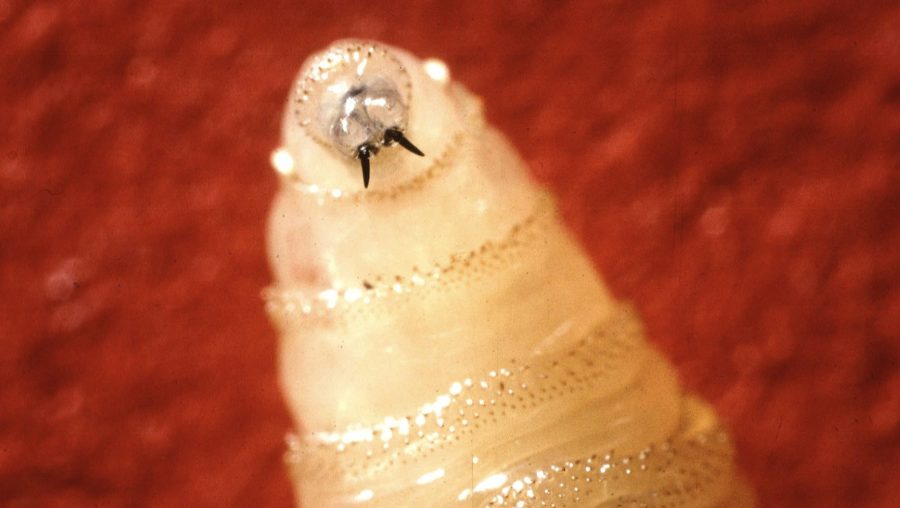Science
High-Tech Solutions Emerge as Screwworms Approach Texas Border

The invasive New World Screwworm, a flesh-eating maggot, is advancing towards the Texas border, raising significant concerns among officials and livestock owners. The U.S. Department of Agriculture has confirmed sightings of these parasites in Sabinas Hidalgo, located just 70 miles from the U.S./Mexico border. New measures are being implemented to combat this emerging threat.
During a press conference held at the Texas State Capitol on August 15, 2025, Texas Governor Greg Abbott and U.S. Secretary of Agriculture Brooke L. Rollins discussed strategies to prevent the screwworm from spreading into Texas. A new sterile fly production facility is currently under construction in Edinburg, Texas, as part of these efforts.
However, officials are increasingly concerned about the proximity of the infestation. “We’ve got this thing, it’s 70 miles from Laredo; it’s at our back door,” said Sid Miller, Texas Department of Agriculture Commissioner. In response, Miller has requested the deployment of TDA Swormlure, a bait designed to assist in pesticide application against the screwworms.
Innovative Approaches to Sterilization
While traditional methods are being discussed, some experts are exploring high-tech solutions to address the screwworm threat. Suresh Pilai, director of the National Center for Electron Research, is developing a method that employs electron beams to sterilize screwworm flies. Currently, radioactive isotopes are used for sterilization, but Pilai’s approach offers a more modern alternative.
“There’s nothing more organic than an electron. We are all made up of electrons, and there’s no radioactivity per se,” Pilai explained. The electron beam technology, already utilized in Europe, is set to be tested in the new Edinburg facility by October 2026. “We basically take electrons accelerated to 99.8% the speed of light, and then they are highly energetic,” he added.
Despite these promising developments, existing technologies are also making a difference today. Ceres Tag, a cattle tracking system, allows ranchers to monitor their herds using GPS technology. This system can track animal movements and behaviors, potentially indicating if a screwworm infection has occurred.
David Smith, founder and CEO of Ceres Tag, described how the tags work: “We’re able to use a sensor that attaches to the ear in a smart tag form, which allows us to monitor the activity and location of the animal.” His system utilizes low Earth orbit satellites owned by Global Star to provide real-time data.
Challenges and Limitations
While Ceres Tag provides valuable information for ranchers, Smith emphasized that it is not a complete solution. “Tracking of the animal is really only one small piece of the puzzle,” he stated. “You can’t predict necessarily where cattle are going to graze; they’re going to graze where they want to graze unless you’re actually guiding them the whole way.”
Smith clarified that his technology aids in timely and accurate application of solutions, rather than being a standalone fix for the screwworm issue. As Texas officials prepare for the potential arrival of these pests, the combination of traditional and innovative methods may be crucial in safeguarding livestock and preventing widespread damage.
With the threat of New World Screwworms looming, Texas is poised to adopt a multi-faceted approach to protect its agricultural sector. As both high-tech solutions and conventional strategies unfold, the focus remains on preventing these invasive pests from causing harm to livestock and the broader ecosystem.
-

 Lifestyle5 months ago
Lifestyle5 months agoLibraries Challenge Rising E-Book Costs Amid Growing Demand
-

 Sports4 months ago
Sports4 months agoTyreek Hill Responds to Tua Tagovailoa’s Comments on Team Dynamics
-

 Sports4 months ago
Sports4 months agoLiverpool Secures Agreement to Sign Young Striker Will Wright
-

 Lifestyle4 months ago
Lifestyle4 months agoSave Your Split Tomatoes: Expert Tips for Gardeners
-

 Lifestyle4 months ago
Lifestyle4 months agoPrincess Beatrice’s Daughter Athena Joins Siblings at London Parade
-

 Science4 months ago
Science4 months agoSan Francisco Hosts Unique Contest to Identify “Performative Males”
-

 World4 months ago
World4 months agoWinter Storms Lash New South Wales with Snow, Flood Risks
-

 Science5 months ago
Science5 months agoTrump Administration Moves to Repeal Key Climate Regulation
-

 Business5 months ago
Business5 months agoSoFi Technologies Shares Slip 2% Following Insider Stock Sale
-

 Science5 months ago
Science5 months agoNew Tool Reveals Link Between Horse Coat Condition and Parasites
-

 Sports5 months ago
Sports5 months agoElon Musk Sculpture Travels From Utah to Yosemite National Park
-

 Science5 months ago
Science5 months agoNew Study Confirms Humans Transported Stonehenge Bluestones









